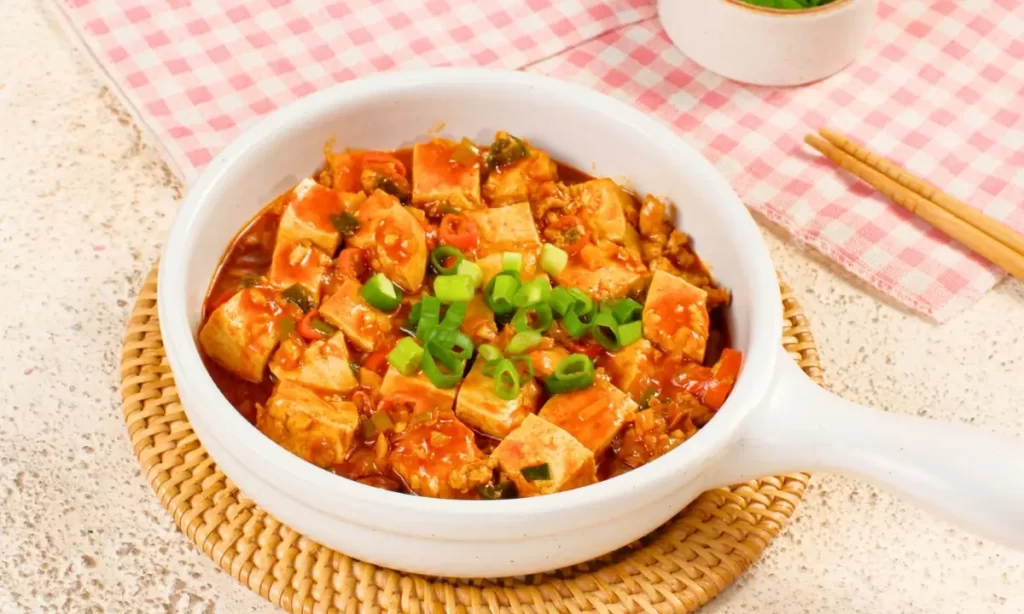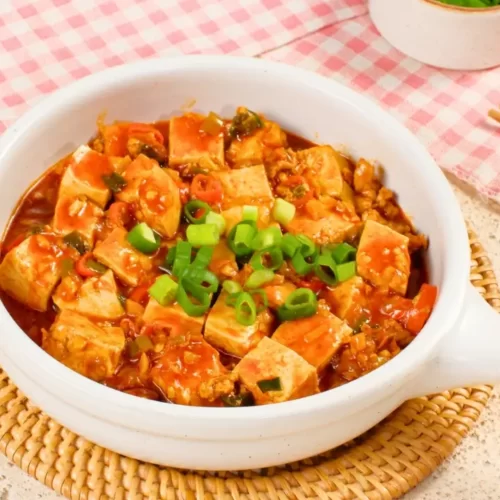
Table of Contents
We are back with yet another popular Korean dish — Korean Mapo Tofu! It is actually a Korean version of the Chinese Mapo Tofu, which originated in the Sichuan province. This recipe only takes 20 minutes of your time and is super delicious for your taste buds.
If you have had Korean dishes before and enjoy having Korean flavors including tofu such as Dubu Kimchi, then surely you are going to love Korean Mapo Tofu. Let’s not waste any time and jump to the recipe directly!
How To Make Korean Mapo Tofu?

Korean Mapo Tofu Recipe
Equipment
- Large Skillet
Ingredients
- 400 grams Of Silken Tofu Cut Into Cubes
- 250 grams Of Pork Grounded
- 2 Cups Of Chicken Broth Or Water
- 3 tbsp Of Cooking Oil
- 1 tbsp Of Toasted Sesame Oil
- 2 Green Onions Finely Chopped
- 2 tbsp Crushed Garlic
- 1 tsp Ginger Julienned
- ½ Green Bell Pepper Finely Chopped
- ⅓ Cup Of Shallots Finely Chopped
- 1 Red Hot Pepper Long & Sliced Thinly
- ½ tbsp Gochujang
- 3½ tbsp Of Gochugaru
- 1 tbsp Of Doenjang
- 2 tbsp Of Soy Sauce
- 1 tbsp Of Oyster Sauce
- 1 tbsp Of Coconut Sugar
- 1 tbsp Of Cornstarch Mixed In 2 tbsp Water
- Salt To Taste
- Pepper Optional
Instructions
- Take a large skillet and add oil. Heat it over low to medium heat.
- Now add the ginger, garlic, shallots, green onions (half), oyster sauce and gochugaru. Sautè everything for 1 or 2 minutes.
- Add the ground pork and stir nicely to break it into tiny little chunks. Cook it until the pink colour is faded.
- Next, add the coconut sugar, salt, soy sauce, gochujang, and doenjang. Stir well so that everything is mixed with the pork nicely.
- Green bell peppers are to be added next and sauteed for at least 20 to 30 seconds.
- Pour in the chicken stock and also add the red hot pepper. Allow it to boil.
- When it comes to a boil, add the tofu pieces and gently mix them well into the sauce.
- Allow it to cook for 5 more minutes and keep stirring sometimes so that the tofu will not stick to the pan.
- Now add the cornstarch & water mixture and let it simmer for a few minutes until you get that perfect thickness for the sauce.
- Drizzle some toasted sesame oil and then remove the skillet from the heat.
- For garnishing the Korean Mapo Tofu, sprinkle some green onions and serve straight away!
Notes
- You can adjust the amount of gochujang and gochujang to balance the level of spiciness.
- Add the salt according to your taste preferences.
- Do not forget to add the coconut sugar, otherwise, your dish will taste too earthy and spicy.
- If you want, you can season the Korean Mapo Tofu with pepper at the end and serve.
- It’s also important to drizzle some toasted sesame oil to balance the spicy flavours.
- To make Korean Mapo Tofu look aesthetic, you can sprinkle some cilantro and scallions sprigs at the time of serving.
Shelf Life
It is best to serve Korean Mapo Tofu fresh. However, you can store it in an airtight container in your refrigerator for up to 2 to 3 days.
Conclusion
So, what are your thoughts on this recipe? Well, a one-pot Korean meal that can easily be made at home is all you need! And if you want to check out some more amazing Korean recipes like this, then you must read more recipes like Soondae Bokkeum and Eomuk Bokkeum. And yes, don’t forget to share your experience with our easy-to-make recipes in the comment box below!
FAQ
What Does Korean Mapo Tofu Taste Like?
The Korean Mapo Tofu is a flavorful dish as it is spicy, tender, aromatic and savoury. It is a perfect mouthwatering dish and has a kick of all the desired flavours.
Is Korean Mapo Tofu Too Spicy?
Yes, Korean Mapo Tofu falls into the spicy side but when you are making it at home, you have the freedom to adjust the amount of spiciness you are adding to the dish. Just adjust the amount of gochugaru & gochujang according to your taste.
Is There Any Difference Between Korean Mapo Tofu And Chinese Mapo Tofu?
There are a lot of similarities between Korean Mapo Tofu & Chinese Mapo Tofu, but both of them differ in ingredients as well as flavours. The Korean-style recipe uses gochugaru & gochujang, which gives a Korean twist to the dish. On the other hand, Chinese Mapo Tofu uses Sichuan Peppercorns, which gives a mouth-numbing sensation, which is not the case in Korean Mapo Tofu.